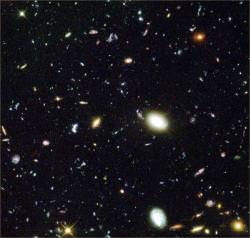Written by Fraser Cain

Dark energy is that mysterious force that seems to be accelerating the expansion of the Universe. But the question is: has it always been pushing the Universe apart with the same force, or was it weaker or stronger in the past, and will it get stronger in the future? Researchers from the Harvard-Smithsonian Center for Astrophysics have a plan to study distant clumps of hydrogen, to get to the bottom of this question, once and for all.
Dark energy was first discovered nearly a decade ago, when astronomers noticed that distant supernovae were further away than their calculations were expecting. Some mysterious force appears to be accelerating the expansion of the Universe from every point in space. As space expands, more dark energy seems to appear. And although the amount of dark energy in any one point in space is tiny, across the vast reaches of space, it really adds up, accounting for more than 70% of the Universe.
If dark energy is increasing, however, you could imagine it eventually becoming so strong that it starts to tear galaxy clusters apart, and then galaxies themselves, and even star systems. Maybe it might even become so strong that it tears apart atoms and even the fabric of space itself. Astronomers call this theory the "Big Rip". Or maybe just the opposite is true, and dark energy will eventually become negligible to the expansion of the Universe.
In order to see if the strength of dark energy is changing over time, astronomers are planning to carefully plot the position of clouds of neutral hydrogen, shortly after they formed from the Big Bang. Although it's not possible now, future planned observatories should be able to trace this material all the way back to a time when the Universe was only 200 million years old.
In the early Universe, small fluctuations in energy density and pressure caused oscillations. Although tiny in the beginning, these ripples have been magnified by the expansion of the Universe so that they stretch 500 million light-years across today. The clouds of neutral hydrogen should follow the same ripple pattern, so astronomers will know they're looking at those first, primordial clouds, and not some closer ones.
And so, astronomers will be able to look back in time, and study the distance to the clouds at each epoch in our Universe's expansion. They should be able to trace how much dark energy was affecting space at each time, and get a sense if this energy has always remained constant, or if it's changing.
Their answers will shape our understanding of the Universe's evolution, and its future.
Original Source: CfA News Release



No comments:
Post a Comment